“It’s like Disney World for engineers and contractors,” said one visitor on the tour. The Mechanical Hub team made a quick visit to Apple Valley, Minn., to visit Uponor North America as the company celebrated the grand opening of its newly constructed Uponor Experience Center with a “pipe-cutting” ceremony. The team was treated to a Read more
piping

“It’s like Disney World for engineers and contractors,” said one visitor on the tour. The Mechanical Hub team made a quick visit to Apple Valley, Minn., to visit Uponor North America as the company celebrated the grand opening of its newly constructed Uponor Experience Center with a “pipe-cutting” ceremony.

Andres Caballero (fifth from left) performs the pipe cutting for the new Uponor Experience Center.
The team was treated to a behind-the-scenes tour of the new 4,500-sq.-ft. customer experience center, which features hands-on displays, full-scale residential and commercial training areas, and cutting-edge innovation showcases, and a place to bring MEP students from the area to get a taste of the trades. The new Uponor Experience Center is a flexible education and discovery space designed to advance the technical skills of current and potential customers. In addition, it will help foster innovation within the plumbing and HVAC industry and provide an immersive experience for employees and visitors alike.

Some displays mimicked true applications.
The new Uponor Experience Center occupies the company’s previous customer training area, which was originally built in 2000 and renovated in 2010. It is at the center of the North American headquarters campus, surrounded by corporate offices, an R&D facility, and manufacturing space.
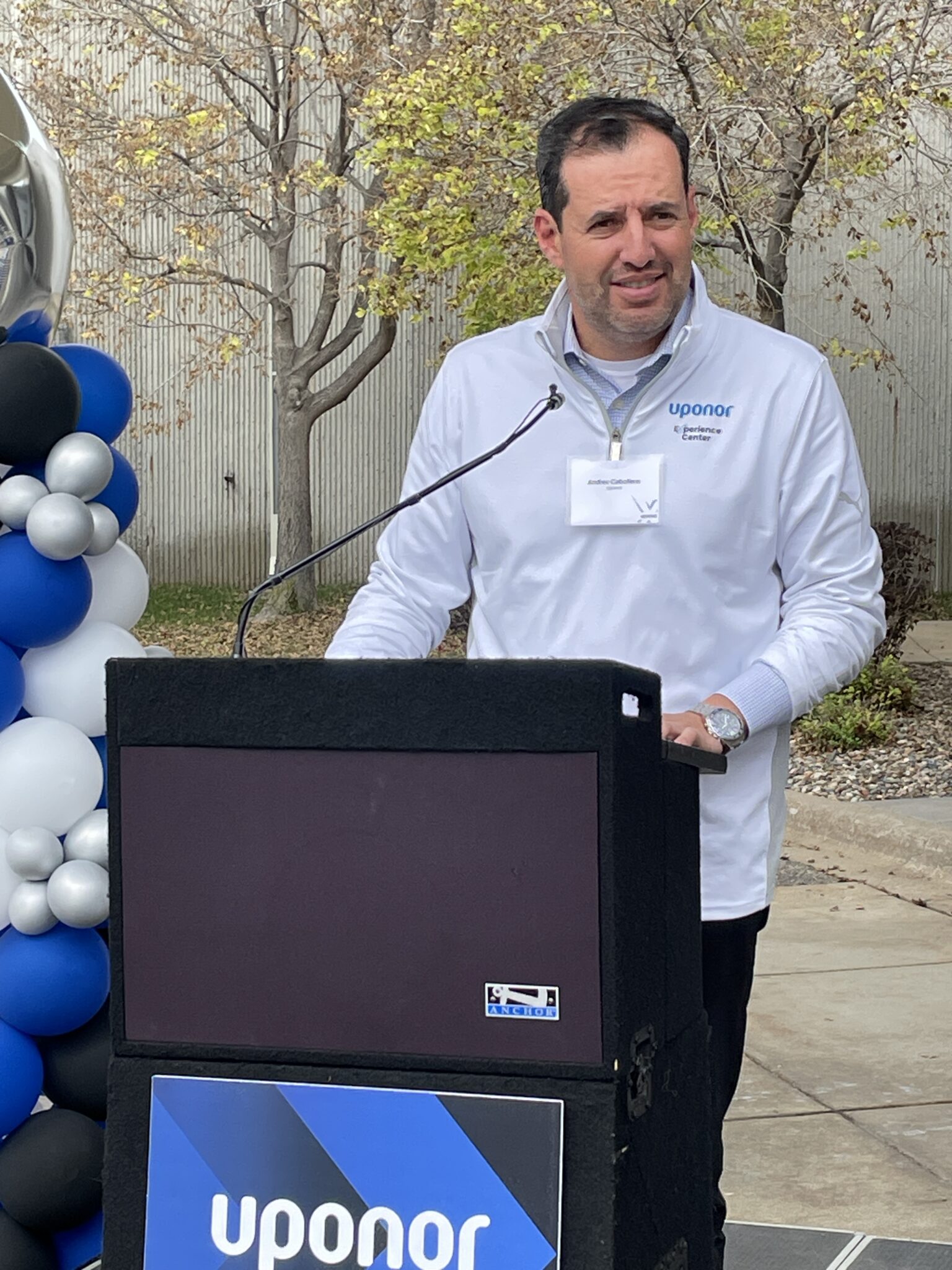
Andres Caballero thanks his staff for all of the hard work and dedication that went into planning and constructing the experience center.
“The opening of our new Uponor Experience Center signifies the importance we place on keeping the needs of our customers, employees, and key stakeholders top of mind as we continue our mission of becoming the global leader in sustainable water and energy solutions,” says Uponor North America President Andres Caballero. “The ‘X’, as our employees have begun to call it, is a culmination of our rich history and decades of innovation coming together to generate awareness and create enthusiasm for moving water more efficiently, effectively, and sustainably.”
With original concepts beginning back in 2020, the Uponor Experience Center was several years in the making. The thoughtful design, which takes into consideration the company’s rich Finnish roots, resulted from many months of internal team collaboration, as well as feedback from customers, partners, and industry influencers.

Mechanical Hub took the opportunity to record parts of the Appetite for Construction podcast with Des Clancy, director of training, Uponor, and the “architect” for the new center.
As guests move through the front doors toward the back of the space, they first experience displays depicting who Uponor is as a company along with the customers served and the unique value provided to key audiences and the industry.

Experience center visitors will get the full hands-on treatment as seen here with one of its gracious partners Milwaukee Tool and its PEX Expander.
Then, there are product showcases and interactive displays for plumbing, fire safety, radiant heating/cooling, hydronic piping, and pre-insulated piping system solutions for residential and commercial markets. Finally, there is an oversized training area, featuring both wood and steel structures, where professionals will learn proper hands-on installation techniques as well as how Uponor’s emphasis on problem-solving and productivity delivers results for their businesses.

Doug Vetter, center, and Brian Spjut, left, from Vetter Plumbing, came all the way from Seattle to get a first glimpse of the space. (Pictured right is Uponor’s Dan Hubbard.)
“We wanted the Uponor Experience Center to extend beyond simply training customers on our products and systems,” says Vice President of Sales Matt Bahr. “As a result, we’ve created a holistic experience that spans a broad spectrum of who we are as a company, showcasing the depth and breadth of our product portfolio and sustainable solutions as well as providing access to the best trainers in the industry.”
With the focus not only on customers but also employees and those in the community, Director of Training Des Clancy says the planning team was very thoughtful about creating an elevated experience for everyone.
“At any given time, we will have contractors, builders, engineers, owners, students, employees, civic leaders, and other guests coming through the doors,” he says. “From tours and training, to onboarding and education sessions, the Uponor Experience Center offers something for everyone, and we are proud to showcase all we are offering to the industry and our community.”

Mechanical Hub’s John Mesenbrink (l) and Tim Ward (r) complete the “Uponor sandwich” as they also toured Uponor’s Distribution Center in Lakeville, Minn., with tour guide and director of logistics and warehousing, Nate McIntosh.

Uponor TotalFit™ is the professional-grade, engineered polymer (EP), push-to-connect fitting system that provides greater value for residential projects with the same versatility and speed as brass push-to-connect fittings. Designed for use with copper, CPVC, PE-RT, and PEX piping systems, TotalFit is ideal for service repair, maintenance, remodels, and retrofits for hot and cold potable-water piping Read more
Uponor TotalFit™ is the professional-grade, engineered polymer (EP), push-to-connect fitting system that provides greater value for residential projects with the same versatility and speed as brass push-to-connect fittings.
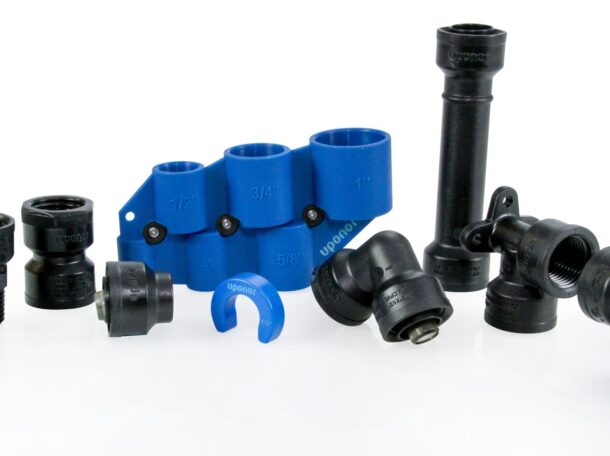
Designed for use with copper, CPVC, PE-RT, and PEX piping systems, TotalFit is ideal for service repair, maintenance, remodels, and retrofits for hot and cold potable-water piping systems in single-family homes, townhomes, apartments, condominiums, dormitories, and more.
With an innovative design for a strong, long-lasting, trusted connection, a 25-year product warranty, and durable EP materials that offer an average of 30% savings over brass push-to-connect fittings, TotalFit is fit for a pro.
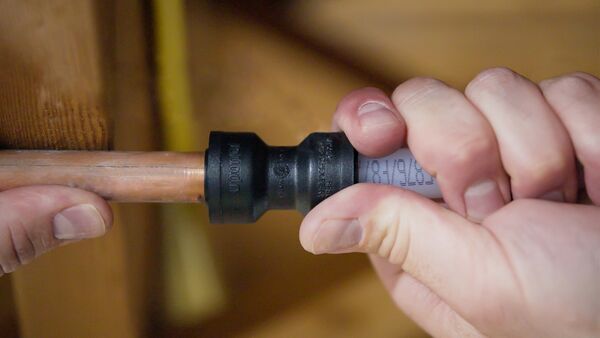
The complete offering includes 33 of the highest-volume push-to-connect fittings in sizes from ½” to 1″ to meet the greatest market need. TotalFit also meets or exceeds all performance requirements for ASTM F877 and ASSE 1061 and is approved by the IPC and UPC for direct burial in soil or concrete (with 4 to 6 mil poly wrap) as well as behind walls without access panels.

Businesses that entrust their data storage to the state-of-the art Novva data center outside of Salt Lake City will benefit from a location chosen for its many data center-friendly attributes. The area offers outstanding connectivity, low power costs, and a central-western site with easy access to a major international airport. In addition, the site’s climate Read more
Businesses that entrust their data storage to the state-of-the art Novva data center outside of Salt Lake City will benefit from a location chosen for its many data center-friendly attributes. The area offers outstanding connectivity, low power costs, and a central-western site with easy access to a major international airport. In addition, the site’s climate and 5,000-ft. altitude allow for many hours of free cooling annually.
Just as important to Novva’s clients, the new data center has a low disaster risk. The area is not prone to earthquakes, floods, or adverse weather events such as hurricanes.

And finally, for the additional peace-of-mind that makes this data center truly start-of-the-art, the cooling system for the computer servers boasts Aquatherm PP-RCT piping that will provide virtually leak-free service for decades to come. The Aquatherm piping will never scale or corrode, and the cooling water flow will remain unchanged throughout the anticipated 50-year lifespan of the pipe. All of this data adds up to a win for Novva and its clients.
The “hyperscale” data center in Salt Lake City will be Novva’s flagship data center. The 100-acre Utah campus is planned to ultimately include more than 1.5 million square feet of data center space and will accommodate 250kW to 30 MW clients. The construction is taking place in four phases. The first phase, which includes a 300,000-sq.-ft. data center, a 120MW substation and an 80,000-sq.-ft. headquarters office building for Novva, was completed in December 2021.
Beating the Heat
Reliable cooling systems are an essential component of modern data centers. Computer servers are notorious for generating heat—and heat is notorious for being an enemy of computer servers.
The decision to install Aquatherm pipe as part of the new data center’s cooling system was driven by Steven Boyce, vice-president of infrastructure and design at Novva Data Centers. Boyce has been involved in the IT and data center space for more than 20 years, and has worked on multiple successful startups during that time.
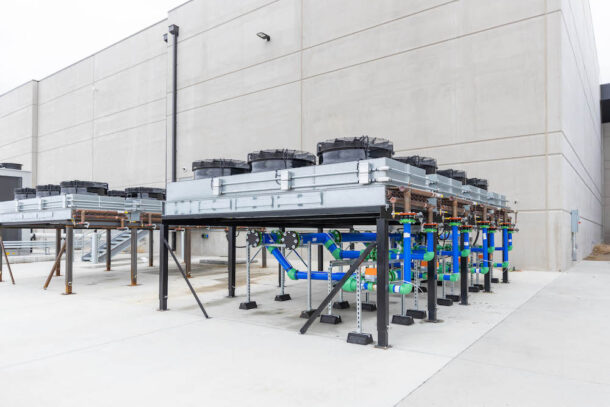
When I first learned about Aquatherm, it was a no-brainer,” Boyce said. “I had been using steel pipes in my builds, which would corrode and rust, and in turn, fill my equipment with sediment and pieces of rust. Efficiencies would be diminished, and the pipes would eventually have to be replaced. Aquatherm’s total installed costs are lower, and their warranty is something that no steel vendor could match.”
Once the decision was made to trust the cooling system’s performance to Aquatherm pipe, Novva turned to the Salt Lake City branch of Harris Mechanical for the installation.
Harris had experience installing Aquatherm pipe, although the Novva data center represented the company’s largest data center Aquatherm installation to date. To handle the first phase of the Novva system, Harris installed a BASX custom chiller package (which included the pumps and controls), the Aquatherm pipe for computer system cooling, and the comfort system piping and plumbing. The piping work for phase 1 began in mid-May 2021 and was completed in October 2021. The system was commissioned and turned over to the owner in December 2021.
Fast and Furious
Jeff Reading, operations manager, construction, Harris Mechanical, explained that the Novva data center started out as a core and shell project, with the office built first and the data hall scheduled to be built out later. However, as anyone in construction work knows, it’s always best to expect the unexpected.
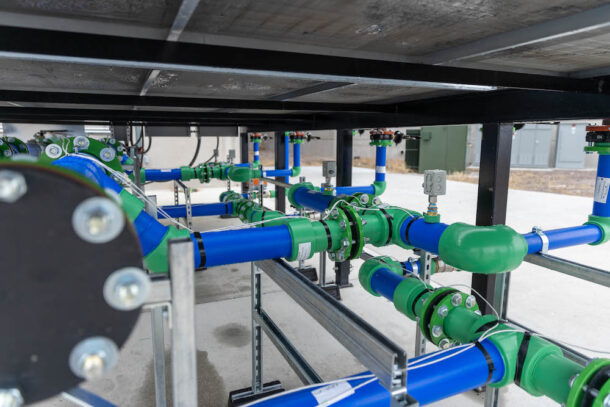
“We finished the core and shell construction in May 2021, and the data hall was right on its heels as a change order to the original project. So it came at us fast and furious,” Reading said. “The original plan was to complete the entire chilled water loop, which runs underneath the floor on both sides of the building. However, it was decided to install the piping in stages as the facility is built out. So far we have installed about half of the piping that will ultimately go in there.”
The installation to date has included 4,418 ft of Aquatherm Blue Pipe SDR 17.6. The main system piping is 10-in., and the takeoffs are 4-in.
Training Professionals
To handle such a large project. Harris Mechanical sent several installers to Aquatherm’s U.S. headquarters in nearby Lindon, UT, for training.
Having Aquatherm-trained technicians opens up new opportunities for HVAC and plumbing companies. The company gains differentiation in the market, and enjoys the time- and labor-savings associated with installing polypropylene pipe.
Aquatherm training is the most intensive, comprehensive training in the polypropylene piping industry. Attendees receive both classroom training and hands-on training with multiple fusion machines, and must pass a rigorous test using all the fusion tools correctly.

After the training, Harris completed the installation using McElroy fusion tools and a combination of socket fusion for the 4-in. pipe and butt fusion for the 10-in. pipe. The system runs at a low pressure (35 to 45 psi); the cooling system supply water runs at 55°F and returns to the chiller at about 60°F.
According to Reading, Harris Mechanical had a good experience with Aquatherm piping at the Novva data center, and the ease of installation compared to steel pipe helped Harris stay ahead of the project’s tight schedule.
“It was a smooth process,” he said. “We definitely gained experience and confidence with the pipe throughout the project, and our installers became accustomed to ‘leapfrogging’ and working with more than one [fusion] machine at a time.”
A Smooth Path
The underfloor piping system presented one of the major installation challenges at this project. The floor is raised 5-ft., and all of the facility’s piping, wiring, HVAC ducting, and utilities run through the raised space.
Aquatherm’s building information modeling (BIM) capabilities and Scan-to-Fab service helped ensure that the installation went smoothly by preventing underfloor conflicts and collisions.
“Using 3D BIM and Revit really helped with coordinating this installation,” said Autumn Turner, a fabrication drafter at Aquatherm. “Not only was all the HVAC and plumbing under the floor, there were floor stands every square foot. It took a lot of coordination to avoid all those potential obstacles.”
Turner noted that careful coordination enhanced the already-fast heat-fusion installation of Aquatherm pipe, and that less time and money spent on welders is a major benefit of choosing Aquatherm.

“Aquatherm is just easier work with than steel pipe,” she said. “It takes a lot less time to weld, and when you add in the BIM support and drafting it was easier for the installers to get situated into the floor and navigate the space.”
Turner added that Aquatherm’s BIM and Revit capabilities will ensure the future installation phases of the massive project also go smoothly.
Rhett Coles, Aquatherm’s fabrication drafting/scan-to-fab manager, said that Aquatherm’s Scan-to-Fab service and in-house fabrication makes any piping installation easier and smoother. Spools can be custom made in any size or configuration and shipped to the jobsite ready to install. In addition, any pieces fabricated by Aquatherm are covered by a comprehensive 10-year warranty.
“In the case of the Novva data center, we were in constant communication with Steven Boyce and the owner’s group,” Coles said. “We were not providing a cookie cutter system to them. They would tell us whatever they wanted or needed and we would work directly with them to help them fully accomplish their goals.”
A reliable, leak-free piping system with a long life span, and a smooth installation in any space, including challenging underfloor designs? The data are in: Aquatherm is the right choice for data centers.

Welcome to another edition of our Hub Spotlight series where do a deep dive into the men and women who make the trades great. This spotlighted tradesperson tells us that he really enjoys trashy reality TV. “Nothing like kicking your feet up and watching someone making horrible life decisions on 90-Day Fiancé on a Sunday Read more
Welcome to another edition of our Hub Spotlight series where do a deep dive into the men and women who make the trades great. This spotlighted tradesperson tells us that he really enjoys trashy reality TV. “Nothing like kicking your feet up and watching someone making horrible life decisions on 90-Day Fiancé on a Sunday evening.” Joking aside, for Keith McGillivary (@mps_207)—full-time business owner of McGillivary’s Plumbing Services (MPS), Gardiner, Maine, for the past two years—his story into the plumbing trades is an interesting one.
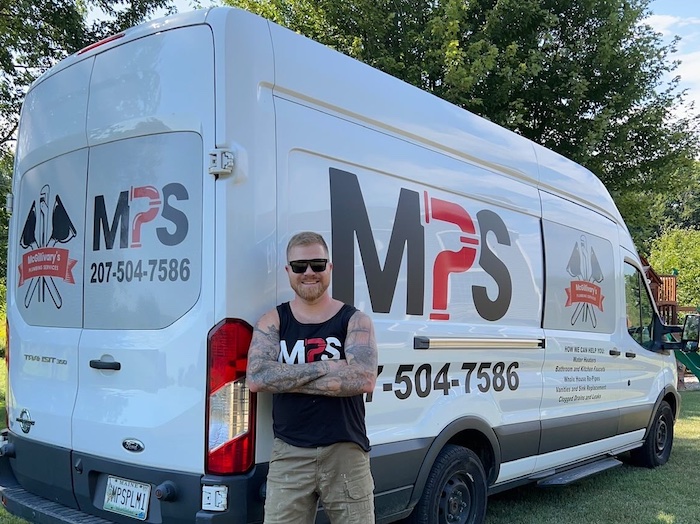
McGilivary’s path started in a small town when a small plumbing business was looking for a helper, and he was looking for a job. “Little did I know it would be the start of where I am now,” says McGillivary. Before college, McGillivary started working for a small plumbing business that primarily focused on service work. The owner, Russell, was/is a great mentor and really took the time to help him understand not only what they were doing, but why they were doing it.
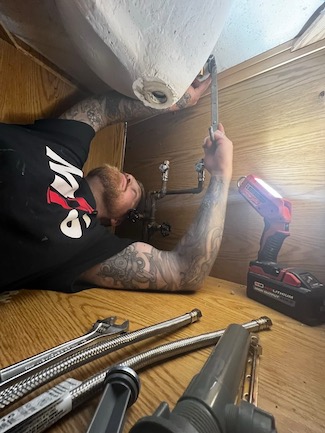 After deciding to pursue plumbing, McGillivary attended Southern Maine Community College (SMCC) for its plumbing and heating program. Through college, he continued to work alongside his mentor, and after graduation, continued to work for him full time for three years. McGillivary then took a job at Bath Iron Works (BIW) as a pipefitter building destroyers, ships for the United States Navy. “The piping systems were complex, and although it was “plumbing on a ship,” it was completely different. I found it fun to learn the ins and outs of that particular plumbing,” says McGillivary.
After deciding to pursue plumbing, McGillivary attended Southern Maine Community College (SMCC) for its plumbing and heating program. Through college, he continued to work alongside his mentor, and after graduation, continued to work for him full time for three years. McGillivary then took a job at Bath Iron Works (BIW) as a pipefitter building destroyers, ships for the United States Navy. “The piping systems were complex, and although it was “plumbing on a ship,” it was completely different. I found it fun to learn the ins and outs of that particular plumbing,” says McGillivary.
Eventually, McGillivary joined the Pipefitter Test Crew and tested the piping systems after they were built. He worked there for six years, but the whole time he continued to work nights and weekends doing plumbing work on the side. “This allowed me to gain hours and knowledge for my Master’s test. After passing my Masters, I decided to make the plunge into self-employment because I wanted the schedule flexibility for my family,” says McGillivary.
 In fact, McGillivary’s biggest motivation for self-employment was time, rather than money. “I have learned to set firm boundaries for myself when scheduling and taking on jobs. I have been able to take more time off for my family than ever. Being a service plumber, in this day in age, you could work 24/7 if you wanted. I try to work ‘normal’ hours, and if I can take a day off for family stuff, I always do,” says McGillivary.
In fact, McGillivary’s biggest motivation for self-employment was time, rather than money. “I have learned to set firm boundaries for myself when scheduling and taking on jobs. I have been able to take more time off for my family than ever. Being a service plumber, in this day in age, you could work 24/7 if you wanted. I try to work ‘normal’ hours, and if I can take a day off for family stuff, I always do,” says McGillivary.
Shout Out to Mentorship
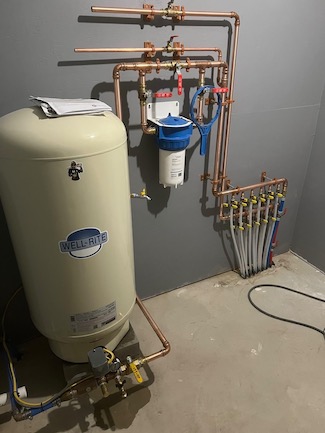 According to McGillivary, Russell taught him everything he knows about plumbing and owning a business. “He taught me all the hands-on work, how to write estimates & bid on jobs, customer relations, and how to balance a small business/family life,” says McGillivary.
According to McGillivary, Russell taught him everything he knows about plumbing and owning a business. “He taught me all the hands-on work, how to write estimates & bid on jobs, customer relations, and how to balance a small business/family life,” says McGillivary.
And McGillivary wants to pay it forward. “I definitely consider myself a role model for others looking to join the trade. I feel I am a good example that hard work and dedication pays off,” says McGillivary. “My mentor was so important to my journey that I try to give back what I can by being transparent about my plumbing knowledge.”
Uplifting the Trades
Recently, there has been a big push for kids to attend trade school so there has been a shift in younger people showing interest, says McGillivary. “Trade school was beneficial for me to learn the code side of things, in an environment different from the hands-on work. I think we could get more interest in the trades if the schools showcased all the different avenues someone could go once they completed their schooling, and the financial opportunities that come with them. Everyone expects a doctor to make six figures, but not everyone knows you can make that in the trades without massive student loan debt,” says McGillivary.
“Everyone expects a doctor to make six figures, but not everyone knows you can make that in the trades without massive student loan debt.”
Social media can also be used to attract more people to the trades. “I see it all too often when guys in the trade are way too harsh on people for asking questions on Facebook plumbing pages. There are so many people asking questions for the purpose of learning and gaining knowledge. We were all there at some point, so be kind enough to answer the questions in a helpful manner. Social media can also be used to form “new-to-the-trades” communities and to provide seminars,” says McGillivary.
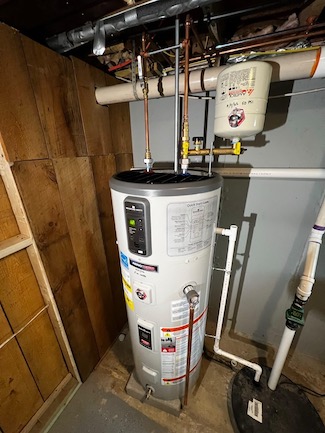 Social media also has played a huge role in the growth of McGillivary’s business. Starting as a small, part-time business with the help of word-of-mouth recommendations on small town Facebook pages, which made McGillivary realize that social media could be used to showcase the work he is doing on a day-to-day basis. “I use my Instagram to show what I am about as a business and the work I put out. I have found that if a customer can see why you are more expensive than the other guy, then they are more likely to go with you. I use it as an open-door insight to my business both in reels and daily stories,” says McGillivary.
Social media also has played a huge role in the growth of McGillivary’s business. Starting as a small, part-time business with the help of word-of-mouth recommendations on small town Facebook pages, which made McGillivary realize that social media could be used to showcase the work he is doing on a day-to-day basis. “I use my Instagram to show what I am about as a business and the work I put out. I have found that if a customer can see why you are more expensive than the other guy, then they are more likely to go with you. I use it as an open-door insight to my business both in reels and daily stories,” says McGillivary.
McGillivary uses social media to learn little tricks of the trade that he just wouldn’t have been exposed to, being from such a small town. For McGillivary, it is extremely beneficial to be able to have conversations with such great tradesmen. He also talks to apprentices daily or weekly about projects, and gives them advice. “I wish when I was learning, I had this platform to learn and meet others. As visual learners, much like a lot of trades guys I know, it’s changed the way we can learn,” says McGillivary.
Making Time
Summers in Maine are short, so McGillivary tries to spend every nice weekend camping in his camper. In the winter months you can find him on his snowmobile at camp. “I would love to ride my snowmobile from camp in northern Maine to the Gaspe Peninsula to complete the “Great Gaspe Snowmobile Tour,” a six-day, 1,500-mile ride around some of the best trails,” says McGillivary.
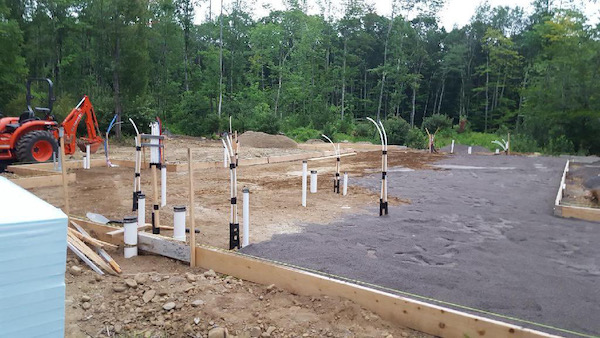
And the last day McGillivary said it was a great day? “You know it’s funny, as I look back on just yesterday—camping with my family, beautiful weather, everyone smiling, does it get much better than that? So, the answer to that question would be yesterday!”
Go-To Tools on the Job
According to McGillivary, his go-tools are a couple pairs of Knipex Cobra pump pliers, a 6-in-1 screwdriver, and an adjustable wrench. Any good service plumber can fix most things with those!
Also, I find myself feeling naked if I don’t have my Leatherman Wave on me. Another great tool that has many uses.
Lastly, if there was one tool that changed the service plumbing game, it’s the M12 Milwaukee press tool. If you’re running a service company and don’t have one, you’re late to the party.

By Aaron Stotko When a century-old Dallas railroad company headquarters required major renovations to transform into a Homewood Suites by Hilton, initial cost estimates for the hydronic heating system came in too high. That’s when City Wide Mechanical of Dallas looked to alternative piping systems for a solution. They found PEX-a pipe with F1960 expansion Read more
By Aaron Stotko
When a century-old Dallas railroad company headquarters required major renovations to transform into a Homewood Suites by Hilton, initial cost estimates for the hydronic heating system came in too high.
That’s when City Wide Mechanical of Dallas looked to alternative piping systems for a solution. They found PEX-a pipe with F1960 expansion connections to be the ideal system, due to its durability and ease of installation in addition to the job-site productivity, safety and, best of all, profitability potential it provided.
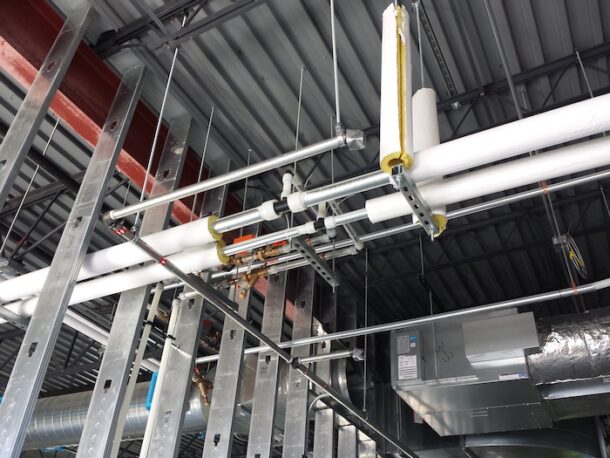
And City Wide Mechanical isn’t alone in their findings. Many mechanical contractors are discovering the benefits of PEX-a pipe and F1960 connections as the preferred alternative to copper, iron, and steel, which have dominated the mechanical piping industry for decades.
Benefits of PEX-a
PEX is an acronym for crosslinked polyethylene. It has been used in North America since the mid-1980s, starting with radiant floor heating systems, then moving into plumbing and, eventually, to hydronic hot-water heating and chilled-water applications.
PEX can be manufactured via three different processes, which create products with varying crosslinking percentages that allow for different characteristics. PEX-a is the most durable, flexible, and resilient with crosslinking around 85%. PEX-b is a stiffer piping product with crosslinking around 65% to 70%, and PEX-c features crosslinking around 70% to 75%.
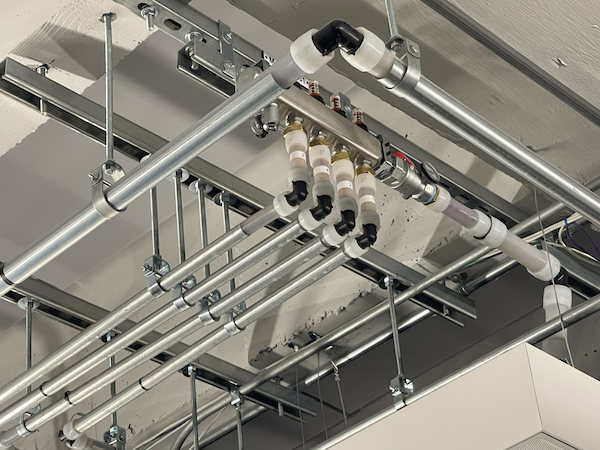
ASHRAE Headquarters Grand Opening Fall 2021, photos by Devin Abellon
One major benefit of the higher crosslinking in PEX-a is its extreme flexibility along with its thermal and shape memory. The flexibility of PEX-a eliminates most connections in smaller-diameter piping, saving time and money with up to half the connections required in rigid metal piping systems. To make a change in direction, the installer simply bends the pipe instead of having to stop and make a fitting. There are also bend supports available that help hold a bend securely in place.
The thermal memory of PEX-a provides kink repairability with a simple shot of heat from a heat gun. This eliminates the need to add in a coupling if a kink ever occurs in the pipe. (It is important to note that kink repairability is not possible with PEX-b or PEX-c pipe.)
The shape memory of PEX-a allows the pipe to expand and contract back down to its original shape. This makes it extremely resilient in freezing conditions and also provides for the fastest, easiest, most reliable PEX-a fitting system — F1960 expansions.

Expansion fittings require one simple tool to expand the pipe and an expansion ring before inserting a fitting. As the pipe and expansion ring naturally shrink back to their original shape, it creates a strong, durable connection that holds tight and can never be dry-fit. (Note: It is not recommended to expand PEX-b or PEX-c pipe due to microcracking that can occur.)
The innovative expansion fitting method eliminates torches, glues, and solder from a job site for greater worker safety. Plus, the system is extremely easy for installers to learn, helping get new crews up to speed quickly.
Speaking of job-site safety, PEX is also much lighter in weight compared with metal systems. For example, a 300-foot coil of 1/2-inch PEX weighs about 18 pounds, whereas the same amount of copper pipe weighs around 85 pounds. The lighter weight of PEX makes it safer and easier for installers to move around a job site and also eliminates the need for heavy-lifting equipment.
PEX-a also has a long-term advantage over copper when it comes to performance longevity. It is a static system, meaning its internal surfaces — which are three times smoother than copper — will not pit, scale, or corrode. That means its performance will remain the same from day one through decades of use.
Finally, because it is not a traded commodity, PEX-a holds a relatively stable material cost. This makes bidding a project much more consistent and reliable.
Application Details and Installation Tips
PEX-a is regulated by the ASTM F876 standard, which denotes temperature and pressure ratings of 200°F at 80 psi (pounds per square inch), 180°F at 100 psi, and 73.4°F at 160 psi. These values are well within the range of operation for most hydronic systems, including chilled beams, fan coil units, baseboards, radiators, hydronic VAV (variable-air volume) reheat coils, and radiant manifolds.
Because PEX is oxygen-permeable, it is important to use a pipe with an oxygen barrier that limits oxygen diffusion to levels below DIN 4726. This will protect the metallic components in the mechanical piping system, such as valves, strainers, and pump volutes, from corrosion.
The pipe is manufactured in sizes from 5/16 inch up to 4 inches and features a copper tube size (CTS) outside diameter. This means all the off-the-shelf components used in a copper hydronic piping system — hangers, supports, and insulation — can be the same.

For horizontal piping, the industry offers PEX-a Pipe Support — a galvanized-steel channel that is 9 feet in length and available in PEX pipe sizes from ½ inch to 3½ inches. This solution enables hanger spacing similar to copper pipe and helps control the natural expansion and contraction of the pipe as it heats and cools.
Because PEX-a expands at 1.1 inches per 100 feet per 10°F Delta T (which is 10 times that of copper), installing anchors every 65 feet and using PEX-a Pipe Supports allows PEX-a to function much like a copper system. In fact, different installation methods have a different effect on the overall net expansion rate.
With a strut-and-clamp system, using PEX-a Pipe Supports and anchoring with fixed points reduces the expansion rate of PEX-a to 0.08 inches per 100 feet per 10°F Delta T (a rate less than copper). And a loop-and-clevis system can reduce the rate to 0.12 inches per 100 feet per 10°F Delta T.
If you’d like to learn more about PEX-a piping systems, visit the Plastics Pipe Institute at plasticpipe.org or the Plastic Pipe and Fittings Association at ppfahome.org.
 Aaron Stotko is the director of Segment Marketing at Uponor. He can be reached at aaron.stotko@uponor.com.
Aaron Stotko is the director of Segment Marketing at Uponor. He can be reached at aaron.stotko@uponor.com.
